Magnolia trees, with their fleeting flowers, and robust foliage are perhaps the most decorative tree you can grow in any garden. The genus is made up of easy going, and incredibly varied plants, ranging widely in size and form, and with flowers that can be a few centimetres across, or up to 30cm.
Either way, for a few, fleeting moments in spring, your garden will pack a floral punch like no other. Thanks to their stunning foliage and fragrant flowers, magnolias have become one of the most popular trees to grow in Australia.
These trees are also easy to care for and can add a touch of elegance and beauty to any outdoor space. In this article, we will provide you with a comprehensive guide on how to grow Magnolia trees in Australia.
More...
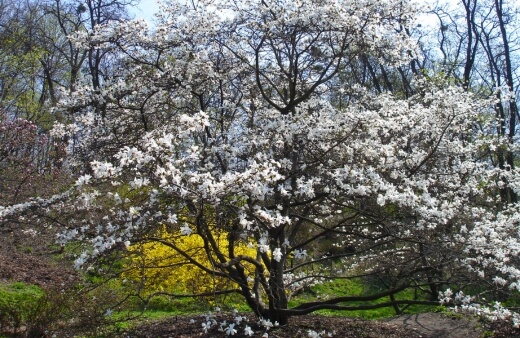
Family: | Magnoliaceae |
|---|---|
Genus: | Magnolia |
Species: | Various |
Common Name: | Magnolia |
Origin: | Asia, North America, Central America, South America |
Location: | Outdoor |
Type: | tree or shrub |
Growth: | varies on species, but typically between 5 and 20 m tall |
Sun requirements: | full sun to part shade |
Foliage Colour: | Green, sometimes with red, grey, or silvery undersides |
Flower Colour: | White, pink, or purple |
Flowering: | Spring or summer |
Fruits: | Conical, inedible fruits that contain red seeds |
Maintenance level: | Medium |
Poisonous for pets: | Not toxic to pets |
Introducing Magnolia Tree
Magnolia is a genus of flowering plants that belongs to the Magnoliaceae family. These trees are native to eastern and southeastern Asia and North America. Magnolia trees can grow up to 80 feet tall and produce fragrant flowers in a variety of colours, including white, pink, yellow, and purple.
And for the more adventurous gardeners out there, their petals are actually edible, with a gorgeous gingery flavour and a surprisingly crisp bite.
Magnolia Tree's Natural Habitat
Magnolia trees are native to a range of habitats, from tropical and subtropical areas to temperate forests, but are most common in Asia and North America, where the vast majority of species are found naturally.
In their natural habitat, these trees grow in acidic, well-drained soil, and prefer full sun to partial shade.
28 Magnificent Magnolia Varieties to Grow in Australia
1. Magnolia stellata Magnolia stellata is a smallish tree, and can be pruned into a multi-stemmed deciduous shrub, with showy white or pink flowers resembling stars. It blooms early in the spring before its leaves emerge, making it a delightful sight, especially after cold winters. | 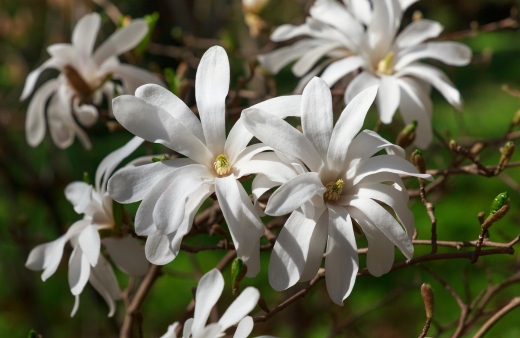 |
2. Magnolia grandiflora Magnolia grandiflora, also called southern magnolia or bull bay, is a large evergreen tree with glossy dark green leaves. It produces large, heavily-scented white flowers in the summer, making it a stunning addition to any garden. | 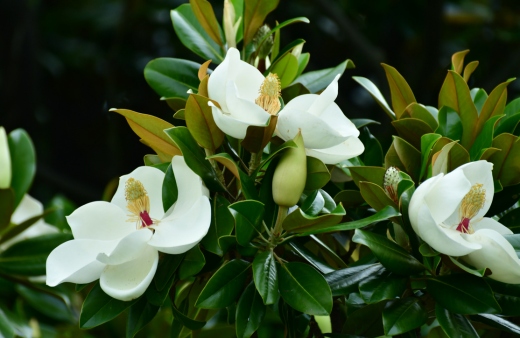 |
3. Magnolia liliiflora Magnolia liliiflora, known as the purple magnolia or tulip magnolia, produces large, cup-shaped pink or purple flowers in the spring. It is a deciduous shrub or small tree that adds a pop of colour to gardens. |  |
4. Magnolia figo Magnolia figo, commonly called banana shrub, is an evergreen shrub with small, creamy yellow flowers that have a strong banana scent. | 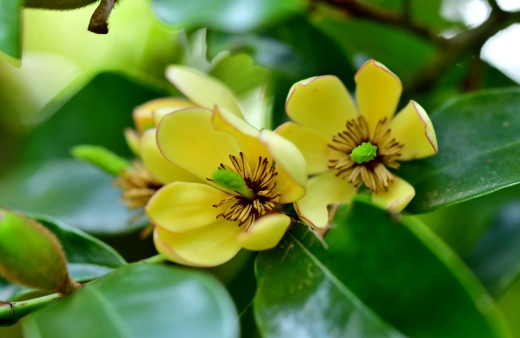 |
5. Magnolia sieboldii Magnolia sieboldii, also known as Oyama magnolia or Siebold's magnolia, is a deciduous tree that produces bold, perfumed white flowers with a pink flush in the spring. It is a stunning plant that will add elegance to any garden. | 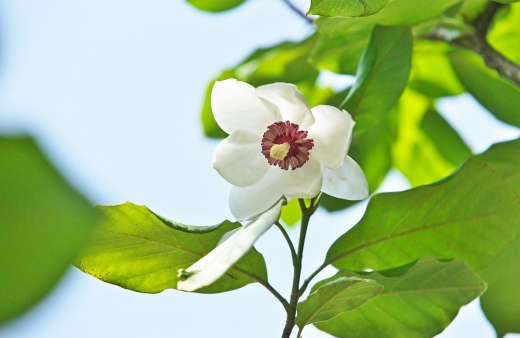 |
6. Magnolia kobus Magnolia kobus is a magnolia tree that produces white or pale pink flowers in the early spring before its leaves emerge. It is a deciduous tree that is perfect for adding some early colour to your garden. | 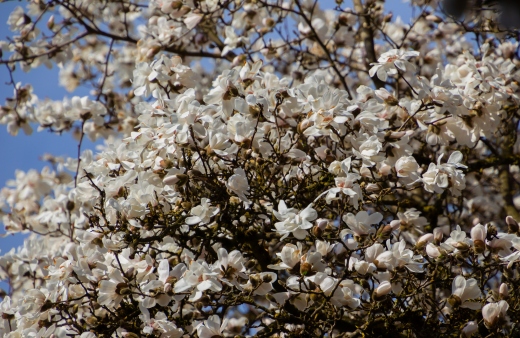 |
7. Magnolia ‘Galaxy’ Magnolia ‘Galaxy’ is a cultivar rather than a true species magnolia, that produces big and aromatic pink flowers in the spring and has glossy green leaves. It is a stunning plant that will add some visual interest to any garden. | 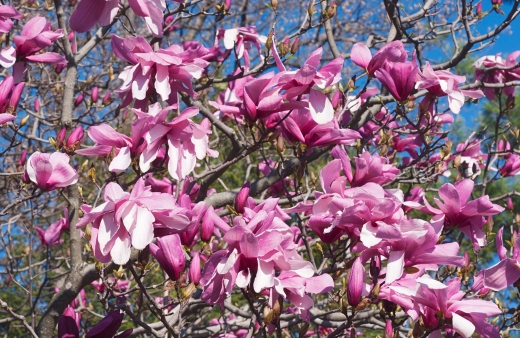 |
8. Magnolia ‘Butterflies’ Magnolia ‘Butterflies’ is a medium-sized magnolia that produces gorgeously scented yellow flowers in the late spring or early summer. The yellow blooms are uniquely gentle, and much more delicate than most cultivars. | 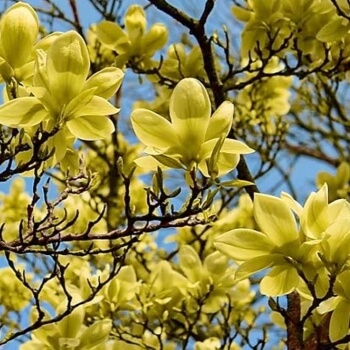 Source: PlantingTree |
9. Magnolia ‘Jane’ Magnolia ‘Jane’ is a hybrid magnolia cultivar that produces huge pinkish-purple flowers in the spring, with a glorious aroma that is best early in the morning. It is a beautiful plant that is sure to stand out in any garden. | 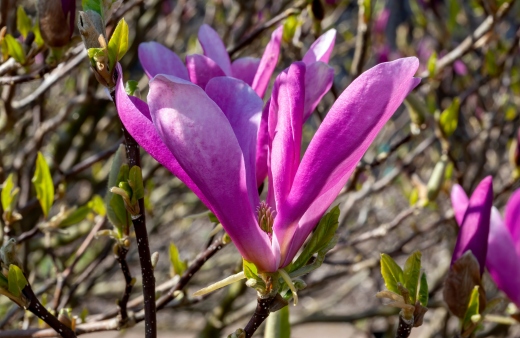 |
10. Magnolia ‘Leonard Messel’ Magnolia ‘Leonard Messel’ is a deciduous shrub or small tree that produces fragrant pink flowers in the spring before its leaves emerge. It is a delicate plant that will add some softness to your garden in spring, but rigid structure through winter. Its upright buds are its best feature though, extending the interest long before flowers open. | 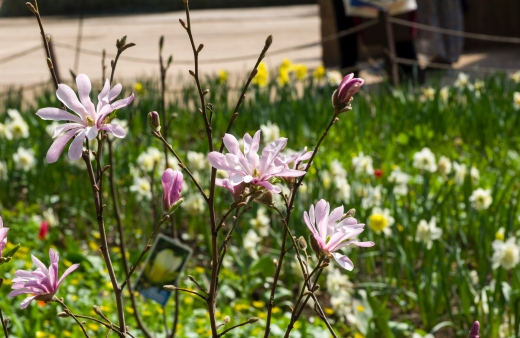 |
11. Magnolia ‘Ann’ Magnolia ‘Ann’ is a magnolia cultivar with deliciously scented reddish-purple flowers in the spring and has glossy green leaves. Like most waxy-leaved magnolias, it looks good in spring, but its summer structure is vastly overlooked, and brings any garden design together perfectly. | 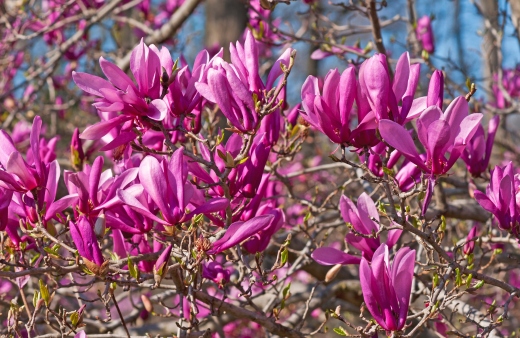 |
12. Magnolia ‘Black Tulip’ Magnolia ‘Black Tulip’ is a medium-sized cultivar with deep burgundy-red flowers in the spring. It is a unique plant that will add some drama to your garden. | 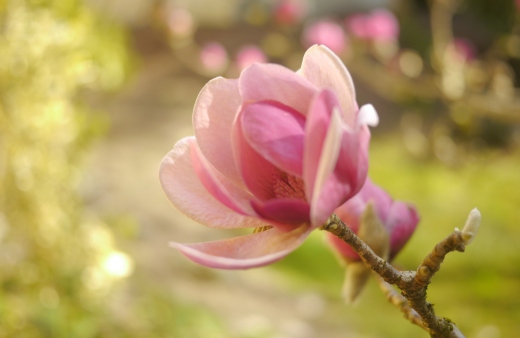 |
13. Magnolia ‘Daybreak’ Magnolia ‘Daybreak’ is a cultivar that produces fragrant pink and white flowers in the spring and has glossy green leaves. It is a stunning plant that will add some visual interest to any garden. | 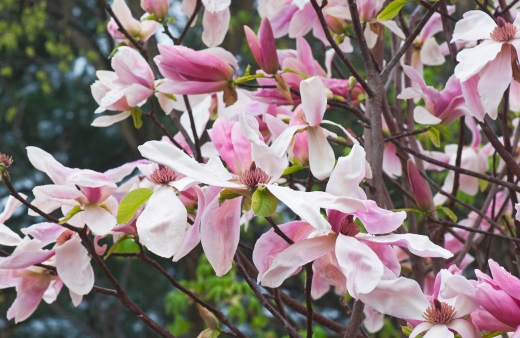 |
14. Magnolia ‘Genie’ Magnolia ‘Genie’ is a small tree but I think it always looks best pruned into a multi-stemmed shrub thanks to its heavy burden of dark purple-red flowers in the spring. For bold colour and form in spring, right through to autumn, you can’t do much better. | 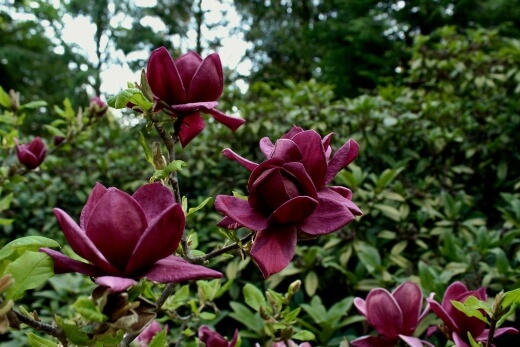 Source: Heritage Fruit Trees |
15. Magnolia ‘Lois’ Magnolia ‘Lois’ is a hybrid magnolia cultivar with pink flowers, each with a delicate white centre in spring. It is a beautiful and fragrant plant that will add softness to your garden, and looks its best when under p[lanted with cream-coloured tulips, or early spring daffodils. | 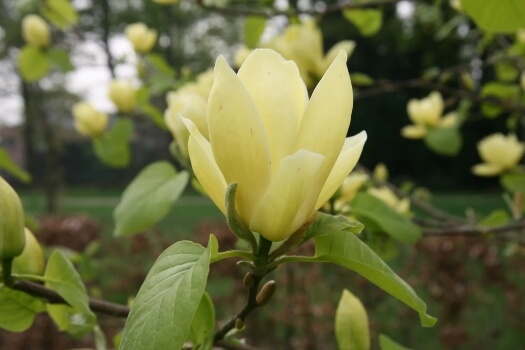 Source: Frank P Matthews |
16. Magnolia ‘Pinkie’ Magnolia ‘Pinkie’ produces abundant pink flowers in the spring before its leaves emerge, filling the garden with delicious scents from morning through to late evening. It is a delicate tree that will add some early colour to your outdoor space. | 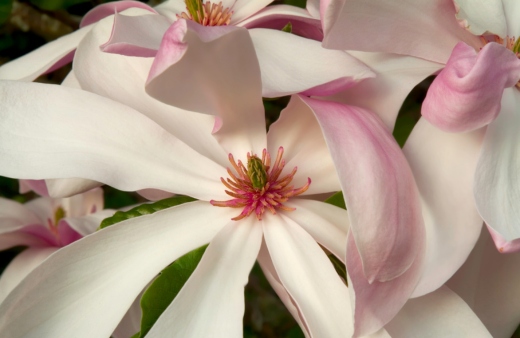 |
17. Magnolia ‘Rustica Rubra’ Magnolia ‘Rustica Rubra’ features large, sweetly-scented, reddish-pink flowers in the spring and dark green leaves with a bronze underside. It is a popular choice for gardens and as a specimen in landscape design due to its prolific blooms and attractive foliage. | 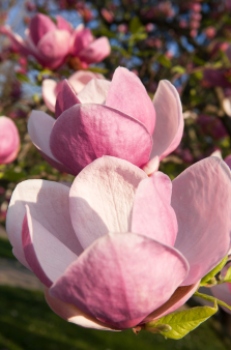 |
18. Magnolia ‘Satisfaction’ Magnolia ‘Satisfaction’ is one of the best magnolias there is, with a spiced fragrance that stands out in a crowd of sweetly fragranced magnolias, and confident reddish-purple flowers in the spring. It is a hybrid magnolia cultivar. |  Source: Tree Shop |
19. Magnolia ‘Spectrum’ Magnolia ‘Spectrum’ has stunningly glossy green leaves that hold right through winter before being pushed out by new growth after flowering in spring. Its foliage is only outdone by its highly fragrant pink blooms. |  |
20. Magnolia ‘Star Wars’ Magnolia ‘Star Wars’, as well as its enticing name, boasts captivating white and pink flowers in spring, and is easy to grow right through Australia, withstanding droughts and monsoons in equal measure. |  Source: Arbode Garden + Home |
21. Magnolia ‘Susan’ Magnolia ‘Susan’, a hybrid magnolia cultivar, packs a punch with deep, crimson flowers that develop into an even deeper purple in spring. It is best used in small spaces, where its compact size and fast development mean you can benefit from its flowers in the smallest gardens, after just two or three years from cuttings. |  |
22. Magnolia ‘Vulcan’ Magnolia ‘Vulcan’ is a hybrid between Magnolia liliiflora and Magnolia sprengeri. It is a deciduous tree cultivar that produces large purple flowers with white centres. The flowers bloom in late spring before the foliage appears. | 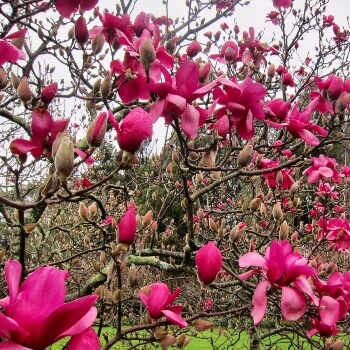 Source: Black Bridge Nurseries |
23. Magnolia ‘Yellow Bird’ Magnolia ‘Yellow bird’ is a hybrid between Magnolia acuminata and Magnolia denudata. It is a deciduous tree that produces large, lemon-yellow flowers with a sweet fragrance. |  |
24. Magnolia ‘Wada's Memory’ Magnolia ‘Wada’s Memory’ is a hybrid between Magnolia stellata and Magnolia ‘Purpurascens’. Its gently scented white and pink flowers have just a hint of purple, and while fleeting, are utterly unforgettable. | 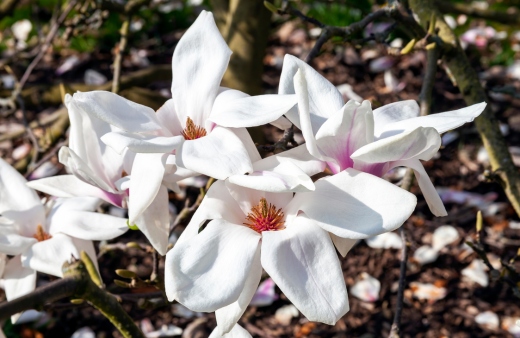 |
25. Magnolia ‘White Caviar’ Magnolia ‘White Caviar’, a hybrid between Magnolia x veitchii and Magnolia x soulangeana, is easily recognizable, thanks to the delicate hint of pinky-purple at the base of each flower. Thanks to its size, and how well it responds to pruning, it is ideal at the back of the border, with annual underplanting. | 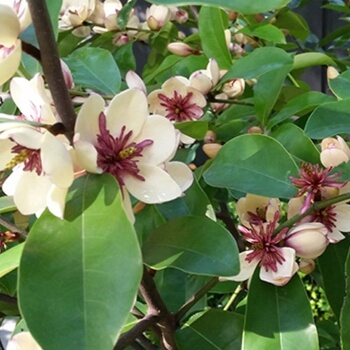 Source: Pot Plant Heaven Perth |
26. Magnolia ‘Teddy Bear’ Magnolia ‘Teddy Bear’ is a hybrid of Bull Bay Magnolia, but is much smaller and more compact, with instantly recognisable waxy leaves, each with a rich russet-coloured underside. It responds well to pruning but can also be left to grow to a final height of about 6 m tall. | 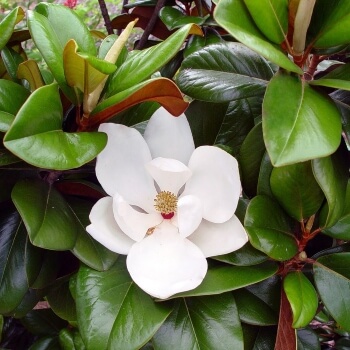 Source: Flower Power |
27. Magnolia ‘Little Gem’ Magnolia ‘Little Gem’ is one of the larger garden Magnolias, reaching up to 9 m tall, and the same width. It's one of the most wonderful shrub magnolias there is, naturally forming a doomed shape, and providing complete ground cover that shades its own roots and reduces the need for watering. | 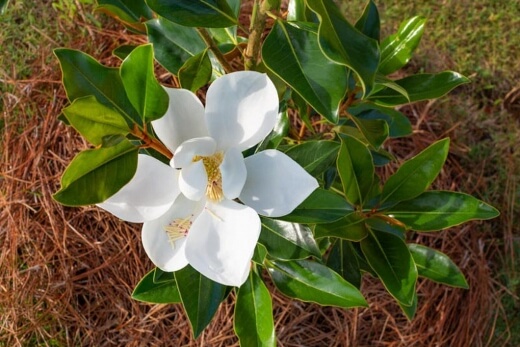 Source: Gardenia |
28. Yulan Magnolia (Magnolia denudata) A large growing Magnolia tree that reaches up to 10 metres tall and wide in gardens. It produces profuse clusters of delicate white blooms that have a lovely lemony scent, easily able to elevate gardens with dramatic floral displays and textures. It can tolerate half-shade to full shade but needs to be planted in a warm, sheltered position in well-drained soil. Will make for an excellent feature specimen or canopy tree. | 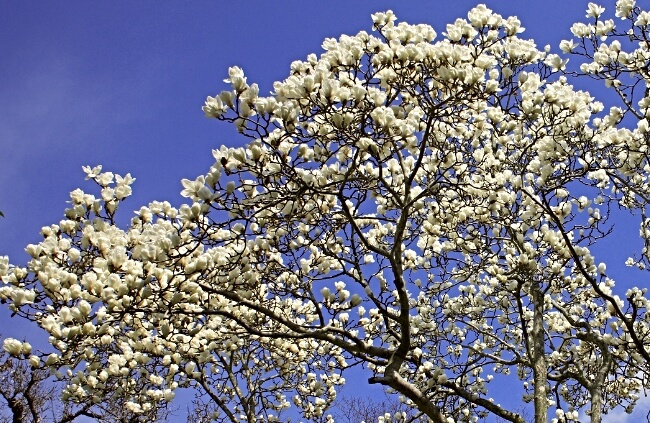 |
28 Magnificent Magnolia Varieties to Grow in Australia
1. Magnolia stellata

Magnolia stellata is a smallish tree, and can be pruned into a multi-stemmed deciduous shrub, with showy white or pink flowers resembling stars. It blooms early in the spring before its leaves emerge, making it a delightful sight, especially after cold winters.
2. Magnolia grandiflora

Magnolia grandiflora, also called southern magnolia or bull bay, is a large evergreen tree with glossy dark green leaves. It produces large, heavily-scented white flowers in the summer, making it a stunning addition to any garden.
Magnolia grandiflora growing guide
3. Magnolia liliiflora


Get Your Free Guide:
Master Growing Australian Natives eBook
A Must Have Complete Guide for Every Australian Garden
Get Your Free Guide:
Master Growing Australian Natives eBook
A Must Have Complete Guide for Every Australian Garden

Magnolia liliiflora, known as the purple magnolia or tulip magnolia, produces large, cup-shaped pink or purple flowers in the spring. It is a deciduous shrub or small tree that adds a pop of colour to gardens.
4. Magnolia figo

Magnolia figo, commonly called banana shrub, is an evergreen shrub with small, creamy yellow flowers that have a strong banana scent.
5. Magnolia sieboldii

Magnolia sieboldii, also known as Oyama magnolia or Siebold's magnolia, is a deciduous tree that produces bold, perfumed white flowers with a pink flush in the spring. It is a stunning plant that will add elegance to any garden.
6. Magnolia kobus

Magnolia kobus is a magnolia tree that produces white or pale pink flowers in the early spring before its leaves emerge. It is a deciduous tree that is perfect for adding some early colour to your garden.
7. Magnolia ‘Galaxy’

Magnolia ‘Galaxy’ is a cultivar rather than a true species magnolia, that produces big and aromatic pink flowers in the spring and has glossy green leaves. It is a stunning plant that will add some visual interest to any garden.
8. Magnolia ‘Butterflies’

Source: PlantingTree
Magnolia ‘Butterflies’ is a medium-sized magnolia that produces gorgeously scented yellow flowers in the late spring or early summer. The yellow blooms are uniquely gentle, and much more delicate than most cultivars.
9. Magnolia ‘Jane’

Magnolia ‘Jane’ is a hybrid magnolia cultivar that produces huge pinkish-purple flowers in the spring, with a glorious aroma that is best early in the morning. It is a beautiful plant that is sure to stand out in any garden.
10. Magnolia ‘Leonard Messel’

Magnolia ‘Leonard Messel’ is a deciduous shrub or small tree that produces fragrant pink flowers in the spring before its leaves emerge. It is a delicate plant that will add some softness to your garden in spring, but rigid structure through winter. Its upright buds are its best feature though, extending the interest long before flowers open.
11. Magnolia ‘Ann’

Magnolia ‘Ann’ is a magnolia cultivar with deliciously scented reddish-purple flowers in the spring and has glossy green leaves. Like most waxy-leaved magnolias, it looks good in spring, but its summer structure is vastly overlooked, and brings any garden design together perfectly.
12. Magnolia ‘Black Tulip’

Magnolia ‘Black Tulip’ is a medium-sized cultivar with deep burgundy-red flowers in the spring. It is a unique plant that will add some drama to your garden.
Magnolia ‘Black Tulip’ growing guide
13. Magnolia ‘Daybreak’

Magnolia ‘Daybreak’ is a cultivar that produces fragrant pink and white flowers in the spring and has glossy green leaves. It is a stunning plant that will add some visual interest to any garden.
14. Magnolia ‘Genie’

Source: Heritage Fruit Trees
Magnolia ‘Genie’ is a small tree but I think it always looks best pruned into a multi-stemmed shrub thanks to its heavy burden of dark purple-red flowers in the spring. For bold colour and form in spring, right through to autumn, you can’t do much better.
15. Magnolia ‘Lois’

Source: Frank P Matthews
Magnolia ‘Lois’ is a hybrid magnolia cultivar with pink flowers, each with a delicate white centre in spring. It is a beautiful and fragrant plant that will add softness to your garden, and looks its best when under p[lanted with cream-coloured tulips, or early spring daffodils.
16. Magnolia ‘Pinkie’

Magnolia ‘Pinkie’ produces abundant pink flowers in the spring before its leaves emerge, filling the garden with delicious scents from morning through to late evening. It is a delicate tree that will add some early colour to your outdoor space.
17. Magnolia ‘Rustica Rubra’

Magnolia ‘Rustica Rubra’ features large, sweetly-scented, reddish-pink flowers in the spring and dark green leaves with a bronze underside. It is a popular choice for gardens and as a specimen in landscape design due to its prolific blooms and attractive foliage.
18. Magnolia ‘Satisfaction’

Source: Tree Shop
Magnolia ‘Satisfaction’ is one of the best magnolias there is, with a spiced fragrance that stands out in a crowd of sweetly fragranced magnolias, and confident reddish-purple flowers in the spring. It is a hybrid magnolia cultivar.
19. Magnolia ‘Spectrum’

Magnolia ‘Spectrum’ has stunningly glossy green leaves that hold right through winter before being pushed out by new growth after flowering in spring. Its foliage is only outdone by its highly fragrant pink blooms.
20. Magnolia ‘Star Wars’

Source: Arbode Garden + Home
Magnolia ‘Star Wars’, as well as its enticing name, boasts captivating white and pink flowers in spring, and is easy to grow right through Australia, withstanding droughts and monsoons in equal measure.
21. Magnolia ‘Susan’

Magnolia ‘Susan’, a hybrid magnolia cultivar, packs a punch with deep, crimson flowers that develop into an even deeper purple in spring. It is best used in small spaces, where its compact size and fast development mean you can benefit from its flowers in the smallest gardens, after just two or three years from cuttings.
22. Magnolia ‘Vulcan’

Source: Black Bridge Nurseries
Magnolia ‘Vulcan’ is a hybrid between Magnolia liliiflora and Magnolia sprengeri. It is a deciduous tree cultivar that produces large purple flowers with white centres.
The flowers bloom in late spring before the foliage appears.
23. Magnolia ‘Yellow bird’

Magnolia ‘Yellow bird’ is a hybrid between Magnolia acuminata and Magnolia denudata. It is a deciduous tree that produces large, lemon-yellow flowers with a sweet fragrance.
24. Magnolia 'Wada's Memory'

Magnolia ‘Wada’s Memory’ is a hybrid between Magnolia stellata and Magnolia ‘Purpurascens’. Its gently scented white and pink flowers have just a hint of purple, and while fleeting, are utterly unforgettable.
25. Magnolia ‘White Caviar’

Source: Pot Plant Heaven Perth
Magnolia ‘White Caviar’, a hybrid between Magnolia x veitchii and Magnolia x soulangeana, is easily recognizable, thanks to the delicate hint of pinky-purple at the base of each flower.
Thanks to its size, and how well it responds to pruning, it is ideal at the back of the border, with annual underplanting.
26. Magnolia ‘Teddy Bear’

Source: Flower Power
Magnolia ‘Teddy Bear’ is a hybrid of Bull Bay Magnolia, but is much smaller and more compact, with instantly recognisable waxy leaves, each with a rich russet-coloured underside.
It responds well to pruning but can also be left to grow to a final height of about 6 m tall.
Magnolia ‘Teddy Bear’ growing guide
27. Magnolia ‘Little Gem’

Source: Gardenia
Magnolia ‘Little Gem’ is one of the larger garden Magnolias, reaching up to 9 m tall, and the same width. It's one of the most wonderful shrub magnolias there is, naturally forming a doomed shape, and providing complete ground cover that shades its own roots and reduces the need for watering.
Magnolia ‘Little Gem’ growing guide
28. Yulan Magnolia (Magnolia denudata)

A large growing Magnolia tree that reaches up to 10 metres tall and wide in gardens. It produces profuse clusters of delicate white blooms that have a lovely lemony scent, easily able to elevate gardens with dramatic floral displays and textures.
It can tolerate half-shade to full shade but needs to be planted in a warm, sheltered position in well-drained soil. Will make for an excellent feature specimen or canopy tree.
Yulan Magnolia growing guideGrowing Magnolia Trees in Australia
How to Plant a Magnolia Tree
The best time to plant a Magnolia tree is in late winter or early spring when the soil is moist and the weather is mild. Before planting, choose a spot in your garden that receives full sun or part shade and has well-draining, acidic soil.
The hole you dig should be at least twice the size of the root ball, and the tree should be planted at the same level as it was in the container.
Soil & Drainage
Magnolia trees prefer acidic soil with a pH between 5.0 and 6.5. To ensure that your tree thrives, you should amend your soil with organic matter, such as compost or aged manure, to improve soil fertility and drainage.
If your garden soil is neutral or alkaline, add ericaceous compost when planting, and regularly add coffee grounds or used tea bags around the base of the plant to gently boost acidity.
Water Requirements
Magnolia trees require regular watering, especially during the first few years after planting. These trees prefer moist, but not waterlogged soil, so it's important to water deeply and thoroughly when you water.
Once your Magnolia tree is established, you can reduce the frequency of watering, but make sure to drench them once a week during droughts and heat waves.
Light & Temperature
Magnolia trees prefer full sun but will cope in partial shade, and can grow in a range of temperatures, but most varieties prefer a temperate climate with mild winters and warm summers.
In extremely warm parts of Australia, some shade from the house in mid-afternoon is advised, and their roots are gentle enough that they won’t damage nearby structures.
Mulching Magnolia Trees
Mulch around the base of your Magnolia tree in mid to late spring, as the weather begins to warm up. This will help retain moisture in the soil, prevent weeds from growing, and regulate soil temperature.
Use a layer of organic mulch, such as wood chips, leaves, or bark, and spread it generously. It’s far better to mulch generously, in 2-3” layers every two or even three years, then mulch lightly once a year.
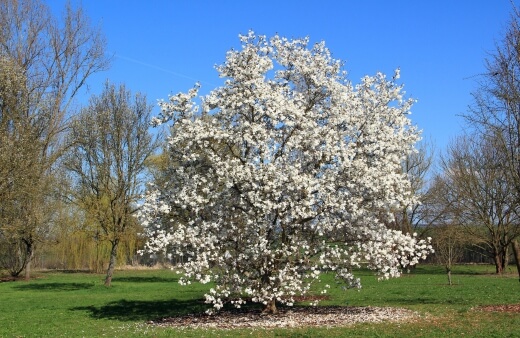
Growing Magnolia Trees in Pots
If you don't have enough space in your garden, or if you live in an area with harsh weather conditions, growing a Magnolia tree in a pot is a good option.
While most magnolias are completely frost hardy, there are a few that benefit from being brought indoors before any frost and others that will flower better in a slightly shady position or with shelter from the wind.
Growing magnolia in pots means you can quickly respond to changing weather conditions, and move them around the garden if they don’t like their situation.
- Choose the Right Pot: Magnolia trees need plenty of room to grow, so choose a large pot that's at least 60 cm deep and has a diameter of at least 50 cm. Make sure the pot has drainage holes to prevent water from accumulating in the soil, which can cause root rot.
- Use the Right Soil: Use a well-draining potting mix that's rich in organic matter. Magnolias prefer slightly acidic soil, so you may need to add sulphur to the potting mix if your soil is too alkaline.
- Water Regularly: Magnolia trees in pots need to be watered more frequently than those planted in the ground. Check the soil regularly, and water when the top 5 cm of soil feels dry to the touch. Make sure to water thoroughly, so the water reaches the roots.
- Fertilise: Magnolia trees in pots need regular feeding to thrive. Use a slow-release fertiliser that's rich in nitrogen, phosphorus, and potassium.
- Prune Regularly: Magnolia trees in pots tend to grow more slowly than those planted in the ground, but they still need to be pruned regularly to maintain their shape and promote healthy growth. Prune your Magnolia tree in the early spring before new growth appears.
- Protect from Cold Weather: Magnolia trees are sensitive to cold weather, so if you live in an area with harsh winters, you'll need to protect your tree from frost and freezing temperatures. Move your Magnolia tree indoors or into a sheltered area when the temperature drops below freezing, and cover it with a blanket or horticultural fleece to protect it from frost.
Propagating Magnolia Trees
If you want to grow a Magnolia tree from scratch, you can propagate it from cuttings. It is possible to grow them from seed, but seeds are rarely sold commercially, and pollination and seed ripening at home are fairly rare.
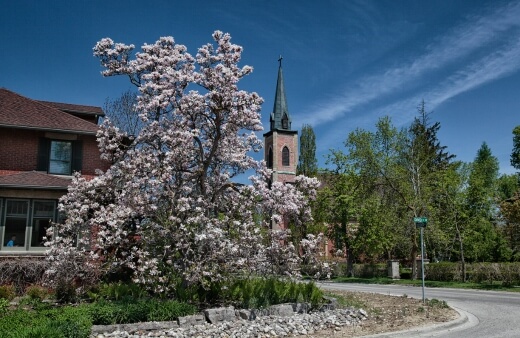
- Take a cutting: In the early summer, take a cutting from the tip of a healthy Magnolia branch that's about 15 cm long. Remove the leaves from the bottom half of the cutting, and dip the cut end in rooting hormone.
- Prepare the soil: Fill a small pot with a well-draining potting mix, and make a hole in the centre.
- Plant the cutting: Insert the cutting into the hole in the potting mix, and gently press the soil around the base of the cutting. Water the soil until it's moist but not soggy.
- Cover the cutting: Cover the pot with a clear plastic bag to create a humid environment that will help the cutting take root. Place the pot in a warm, bright spot, but out of direct sunlight.
- Wait for roots to develop: Check the cutting regularly, and water as needed to keep the soil moist. After a few weeks, the cutting should start to develop roots. Once the roots are well-established, remove the plastic bag, and transplant the cutting to a larger pot or into the ground.
Magnolia Tree Pests and Diseases
Despite being a relatively hardy tree, magnolias are still susceptible to some common pests and diseases. but the most damaging, and often hard to detect, are the species-specific pests, like magnolia webworm.
Scale insects
These small, oval-shaped insects can be found on the undersides of leaves and along branches. Scale insects suck the sap from the tree, which can cause yellowing and stunted growth.
To control them, try using horticultural oil or insecticidal soap.
Magnolia scale
Similar to other scale insects, magnolia scales can be identified by small, brown bumps on the branches and leaves of the tree. Infested trees may develop yellow spots on the leaves or experience stunted growth.
Horticultural oil or insecticidal soap can also help control magnolia scale.
Magnolia borer
This pest can cause significant damage to the tree, burrowing into the trunk and branches. Signs of infestation include small holes in the bark, sawdust-like litter around the base of the tree, and wilting or yellowing leaves.
Any general organic insecticides should be effective against magnolia borers.
Magnolia webworm
The larvae of this moth spin webs around the leaves of the tree, which they then feed on. The damage caused by magnolia webworm is generally cosmetic and doesn't harm the overall health of the tree.
However, if the infestation is severe, you may want to try using an organic pesticide, or cutting out parts of the tree that are severely weakened or infested.
Leaf spot
This fungal disease causes small, yellow spots to appear on the leaves of the tree. Over time, the spots may turn brown and develop a yellow halo. In severe cases, leaf spot can cause defoliation.
To control leaf spot, you can try removing and destroying infected leaves, and applying a fungicide.
Powdery mildew
Another fungal disease, powdery mildew causes a white, powdery coating to form on the leaves and branches of the tree. In severe cases, the leaves may become distorted and drop off.
Pruning infected branches and applying a fungicide can help control powdery mildew.
Canker
This fungal disease causes dead areas on the bark of the tree, which may be discoloured and sunken. The disease can spread rapidly and cause significant damage to the tree.
To control canker, try pruning infected branches and applying a fungicide.
Magnolia Tree Frequently Asked Questions
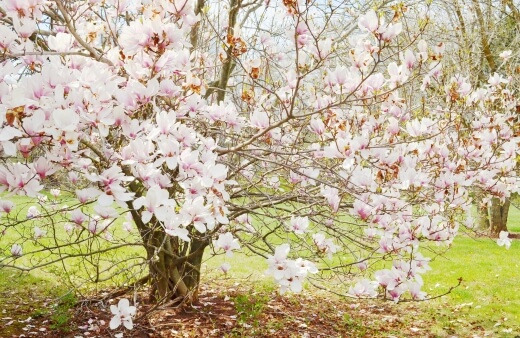
When should I prune my magnolia tree?
Prune magnolias in early to mid-summer if you want to restrict their size, only after flowering has completely stopped, and any seeds have developed and fallen. This encourages new growth through late summer, which will improve the shape, but flowering will be reduced the following year.
Do magnolias like ericaceous soil?
Magnolias prefer slightly acidic soil, so most ericaceous compost mixes are too acidic for them. However, mixing ericaceous compost with a more neutral potting compost or topsoil would provide good conditions.
Do magnolias lose their leaves in winter?
Magnolias are part of a wide genus with lots of variation, including some evergreen and some deciduous species. Most of the magnolias that grow best in Australia are evergreen though, and some deciduous types from cooler climates will hold dormant foliage through winter too.
Wrapping Up Our Magnolia Tree Growing and Caring Guide
Magnolias are one of the most stunning trees you can grow in your garden, with their large, showy flowers and lush waxy foliage. When planting a magnolia tree, be sure to choose a location with well-draining soil and plenty of sunlight.
Water and fertilise your tree regularly, and keep an eye out for any signs of pests or diseases.
Published on December 13, 2023 by Maisie Blevins
Last Updated on October 18, 2025





Still Trying to identify my Magnolia.
Its a multi-stemmed bush with a single bowl about a meter across and is about 7M tall about 70 years old, It is evergreen with leaves about 7-8cm long and produces small pink flowers -a reasonable number but not in profusion – this perplexes me as it doesn't seem to fit with the identification guides.
I assume it must be a cultivar of some description. It looks similar to a Port Wine Magnolia, but they are only supposed to grow 2-3 M tall & this one is 7M. Any Ideas? Can you help?
Hi Simon,
There’s quite a few that it could be, but I’d need to see a picture of it (ideally in flower) to help with identification.
Of the top of my head, I’d maybe suggest Magnolia x soulangeana (they normally have small-medium sized blooms, and shorter leaves, and can flower less prolifically in some conditions), but it could even be that it was a grafted magnolia, where someone has grafted Port wine to a more vigorous rootstock to create a larger tree.
They can get to about 5m tall in some setting though, but I’ve never heard of Port wine getting anywhere near that height, so it could either be a different cultivar altogether or grafted. If it’s grated, there’s sometimes a swell near the base of the trunk, but if it’s getting on for 70, it’s unlikely it would be visible.
If you get a chance, send us over some pictures. I’m intrigued to track this down for you.
Best regards,
Maisie Blevins